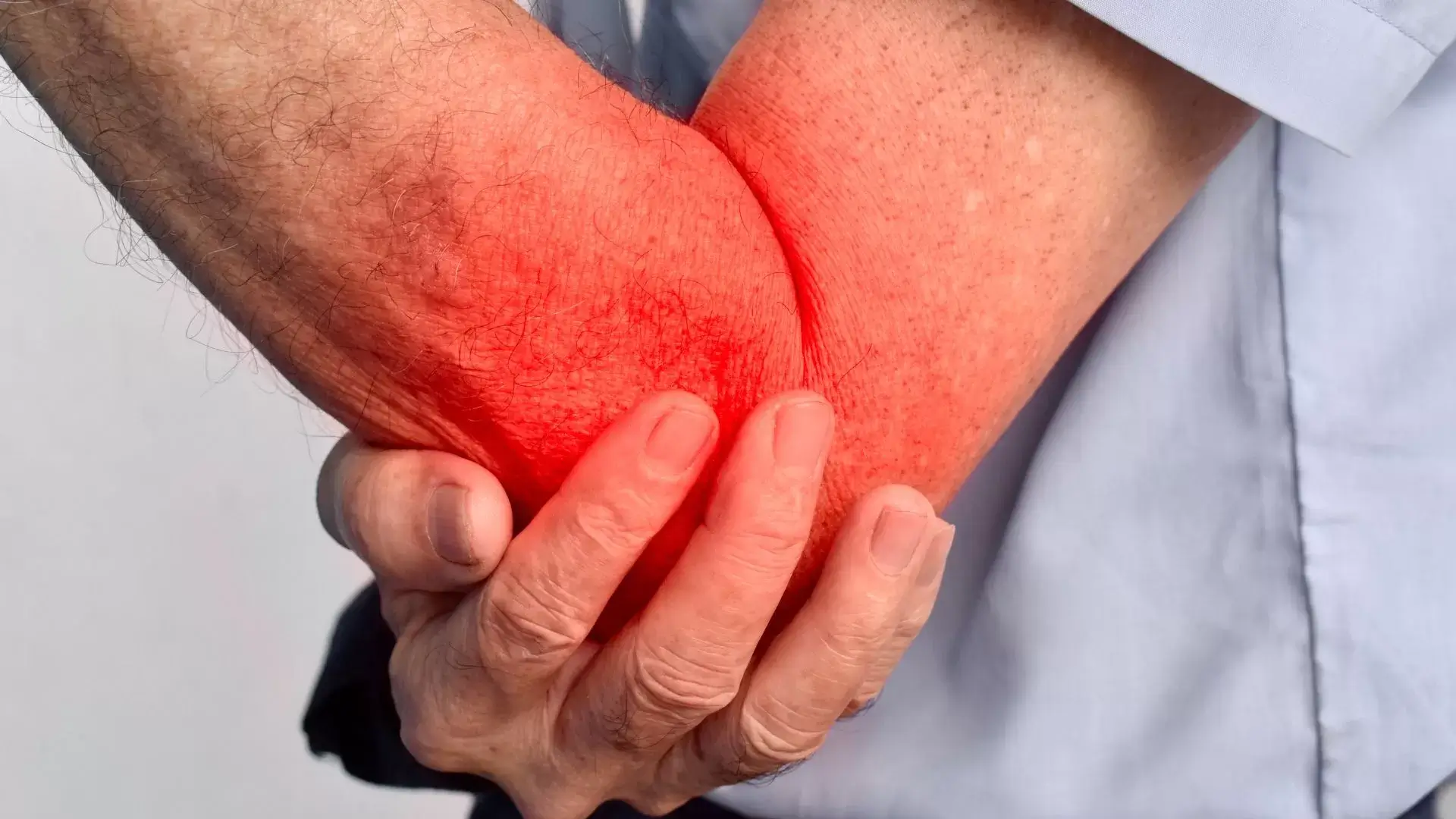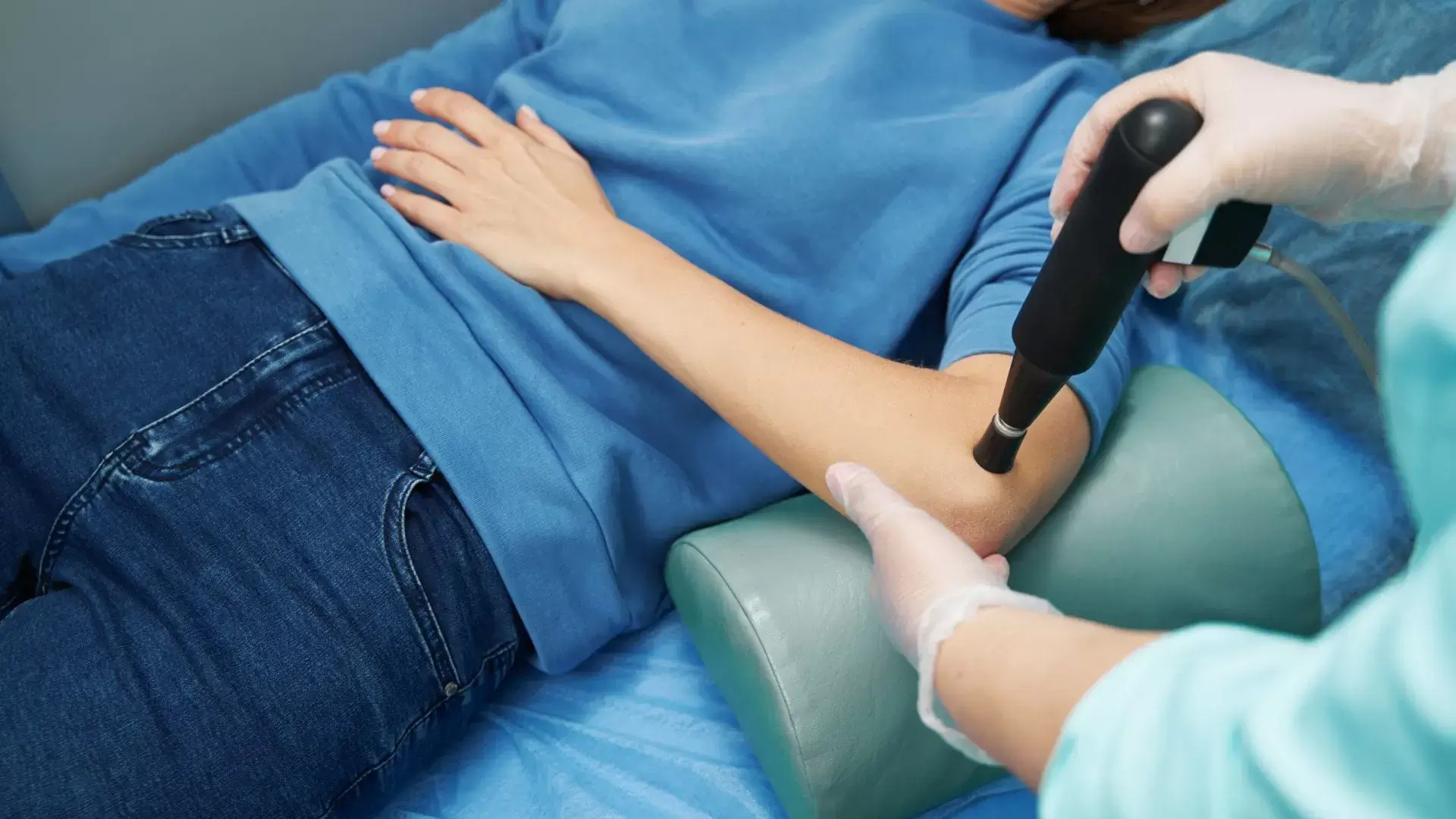We’re dedicated to providing effective physiotherapy for golfer’s elbow in Mississauga. This common condition affects arm strength and mobility due to tendon inflammation, often resulting from repetitive stress. Our Top Mississauga Physiotherapy & Chiropractic Clinic focus on pain relief, flexibility improvement, and strength restoration. We utilize techniques like manual therapy, targeted exercises, and ergonomic strategies for ideal recovery. With our supportive approach, we aim to guide you back to your daily activities without discomfort. If you’d like to explore further options for managing golfer’s elbow, there’s plenty more we can share about our services and strategies.

At Mississauga Physio Chiro Clinic, we specialize in providing extensive physiotherapy and chiropractic services tailored to alleviate the discomfort associated with golfer’s elbow, clinically known as medial epicondylitis. We recognize how elbow pain can greatly impact daily activities and athletic performance, so our team is committed to offering effective elbow rehabilitation strategies.
Our approach focuses on pain management and inflammation relief through individualized treatment plans. We utilize elbow mobility exercises to enhance flexibility and strength, helping patients regain their functional abilities. Additionally, we offer therapeutic massage to further promote healing and relaxation, targeting the muscles surrounding the elbow.
For those seeking non-surgical treatment options, our sports rehabilitation programs are designed to address the unique needs of athletes while ensuring a safe return to their favorite activities. By combining physiotherapy and chiropractic services, we aim to provide a thorough treatment experience that addresses both the symptoms and underlying causes of golfer’s elbow.
If you’re struggling with elbow pain, we’re here to listen and support you on your journey toward recovery. Together, we can work towards restoring your elbow function and improving your quality of life.
Understanding golfer’s elbow is vital, as its impact on arm strength and mobility can hinder both everyday tasks and athletic performance. This condition often manifests as inner elbow pain and forearm pain, stemming from tendon inflammation and elbow strain. When we deal with golfer’s elbow, we must recognize it as a repetitive stress injury that affects our arm biomechanics, leading to decreased elbow mobility and overall function.
The implications of golfer’s elbow extend beyond discomfort; chronic elbow pain can limit our ability to perform simple actions like lifting objects or gripping a racquet. We may find ourselves compensating with other muscle groups, which can lead to further issues down the line. Therefore, addressing elbow strengthening becomes essential.
Through targeted physiotherapy, we can focus on restoring our elbow’s functionality and ensuring that our arm strength is rebuilt effectively. Strengthening exercises not only alleviate pain but also enhance our overall arm biomechanics, promoting better mobility and reducing the risk of future injuries. By understanding the effects of golfer’s elbow, we can take proactive steps toward recovery and return to the activities we love with renewed confidence.
Golfer’s elbow can often be traced back to a combination of repetitive motions, improper technique, and insufficient conditioning, all of which place excessive strain on the tendons in the forearm. This overuse injury typically affects the flexor tendons, leading to conditions such as elbow tendinopathy. We often see that muscle imbalances contribute considerably to this issue, as weak or tight muscles can exacerbate the risk of developing elbow pain.
Engaging in sports or activities that require gripping can further increase the likelihood of a gripping injury, especially if proper ergonomic adjustments aren’t made. For instance, poor posture or incorrect equipment can lead to repetitive motion injuries, putting undue stress on the elbow.
Additionally, tendon degeneration can occur over time with continuous strain, making the tendons more susceptible to injury. As we become more aware of these key causes and risk factors, we can take proactive steps to prevent golfer’s elbow. By addressing our techniques, conditioning, and making necessary ergonomic adjustments, we can minimize our risk and maintain better elbow health.
Recognizing the symptoms of golfer’s elbow is crucial for early intervention and effective management, as it can help us avoid worsening the condition and facilitate a quicker return to our favorite activities. Often, the first signs we notice include persistent elbow pain, which may radiate down our forearm, leading to arm pain and wrist pain. This discomfort can affect our daily routines and sports activities.
We might also experience elbow swelling, which can indicate inflammation associated with elbow tendonitis. As the condition progresses, we may notice grip weakness, making it challenging to hold onto objects. Muscle fatigue in the forearm can further exacerbate our symptoms, limiting elbow function and overall strength.
Additionally, some of us may be aware of tingling or numbness, particularly in the ulnar nerve area, which can signal nerve involvement. Recognizing these symptoms early can guide us to seek appropriate pain relief therapy and preventive measures. By being proactive in identifying these signs, we can work towards regaining our strength and mobility, ultimately enhancing our quality of life and enjoyment of sports.

Effective management of golfer’s elbow symptoms often involves incorporating physiotherapy into our recovery plan, as it offers targeted strategies to relieve pain and restore function. Through physical therapy, we can address elbow pain by focusing on improving elbow flexibility and strength. Our physiotherapist may guide us through specific stretching exercises designed to alleviate tension in the forearm and enhance our overall range of motion.
Incorporating forearm strengthening exercises is essential, as these will not only support the elbow joint but also contribute to long-term recovery and injury prevention. Additionally, modalities such as ice therapy and heat therapy can be integrated into our treatment plan. Ice therapy helps reduce inflammation, while heat therapy can promote blood flow and relaxation of the muscles surrounding the elbow.
We may also benefit from joint mobilization techniques, which help restore normal movement patterns and reduce discomfort. By actively participating in our rehabilitation, we can take significant steps toward overcoming golfer’s elbow. Committing to a personalized physiotherapy program guarantees that we’re on the right path to recovery, allowing us to return to our favorite activities pain-free.
Manual therapy and soft tissue treatments can play an essential role in alleviating the pain associated with golfer’s elbow, helping us regain mobility and comfort in our daily activities. These approaches target the elbow tendons and surrounding muscles, addressing issues like elbow stiffness and acute elbow pain.
One effective method we use is myofascial release, which focuses on relieving tension in the fascia, promoting blood flow, and enhancing flexibility. This technique can be particularly beneficial for those experiencing chronic pain relief challenges. Additionally, neuromuscular therapy helps restore proper function by addressing muscle imbalances that may contribute to discomfort and injury.
Incorporating these treatments can greatly improve elbow recovery, allowing us to return to our regular routines, whether we engage in manual labor or leisure activities. We often complement these techniques with anti-inflammatory treatments to further reduce pain and swelling, providing the necessary elbow support throughout the healing process. By focusing on these manual therapies, we can create an extensive plan tailored to our individual needs, paving the way for a more effective and efficient recovery journey.
After addressing pain relief through manual therapy, we can now focus on incorporating effective strengthening and stretching exercises that are essential for elbow rehabilitation and long-term recovery. It’s important to target both the forearm and wrist flexor muscles to enhance joint stability and improve elbow mechanics.
We recommend starting with gentle stretching exercises to increase flexibility, followed by resistance exercises to strengthen the affected muscles. Using an elbow brace during these exercises can provide additional support and help prevent further injury. Basic wrist curls and reverse wrist curls can be effective in targeting the wrist flexor muscles and addressing tennis elbow symptoms.
Kinesiology taping may also assist in stabilizing the elbow during these activities, allowing us to engage in strengthening without excessive strain. As we progress, we can incorporate more advanced resistance exercises to guarantee balanced muscle development.
Incorporating these exercises into our routine not only aids in recovery from elbow injury but also prepares us for occupational therapy, guaranteeing we return to our daily activities stronger and more resilient. Together, we’ll work towards achieving ideal function and preventing future issues.
Integrating shockwave and ultrasound therapy into our rehabilitation plan can considerably accelerate the healing process for golfer’s elbow. Both modalities offer unique benefits that can enhance tendon healing and alleviate pain associated with this condition. Shockwave therapy uses acoustic waves to stimulate circulation and promote tissue repair, making it particularly effective for elbow ligament injuries resulting from work-related or racket sports injuries.
On the other hand, ultrasound therapy utilizes sound waves to penetrate deep tissues, reducing inflammation and improving flexibility in the affected area. This is especially beneficial for those recovering from throwing injuries, as it helps restore function and mobility.
In conjunction with therapeutic exercises, the use of elbow orthotics or splints can further support recovery by stabilizing the joint during the healing process. While corticosteroid injections may provide temporary relief, combining these therapies often leads to more sustainable outcomes.

While shockwave and ultrasound therapies play a significant role in healing, effective pain and inflammation management through physiotherapy is equally important for those suffering from golfer’s elbow. At our clinic located at 1834 Lakeshore Rd W unit 6C, Mississauga, ON L5J 1J7, we focus on personalized treatment plans that address both pain and inflammation directly.
We begin with a thorough assessment to identify underlying issues, such as nerve compression or reduced wrist stability, which can exacerbate symptoms. By employing techniques like manual therapy and specific exercises, we help reduce pain and promote healing. Additionally, we may incorporate PRP therapy, which has shown promising results in alleviating inflammation and accelerating recovery.
We understand that every patient’s experience with golfer’s elbow is unique, and we’re here to provide empathetic support throughout the journey. If conservative measures are insufficient, we can discuss alternatives, including the possibility of elbow surgery. Our goal is to empower you with the knowledge and tools needed for effective pain management. For more information or to schedule an appointment, don’t hesitate to contact us. Together, we can work towards your recovery and return to the activities you love.
Bracing, kinesiology taping, and ergonomic adjustments can greatly enhance support and stability for those dealing with golfer’s elbow, helping to alleviate strain and promote healing. By utilizing a brace, we can provide targeted compression to the forearm, reducing stress on the elbow joint and surrounding muscles. This not only aids in pain relief but also encourages proper alignment during activities.
Kinesiology taping offers another layer of support. It can help us stabilize the elbow while allowing for a full range of motion. The tape works to lift the skin slightly, improving circulation and reducing swelling, which is vital for recovery.
Additionally, making ergonomic adjustments in our daily activities can greatly impact our comfort and functionality. For instance, we might consider modifying our workspace to guarantee that our arms are positioned correctly and that tools are easily accessible. These small changes can decrease the likelihood of exacerbating symptoms and promote a healthier posture, which is essential for long-term relief.
Together, these strategies form a thorough approach to managing golfer’s elbow, fostering an environment conducive to healing while allowing us to maintain our daily routines with less discomfort.
Addressing golfer’s elbow often involves not just managing muscle strain but also recognizing and treating nerve compression, particularly ulnar nerve pain, which can greatly impact our daily activities. When we experience ulnar nerve pain, we might encounter symptoms like tingling, numbness, or weakness in our hand and fingers. It’s essential to identify these signs early to prevent further complications.
In physiotherapy, we utilize various techniques to alleviate nerve compression. Manual therapy, including gentle mobilization of the elbow and wrist, can help relieve pressure on the ulnar nerve. We may also incorporate specific stretching and strengthening exercises to improve flexibility and stability in the surrounding muscles, which can aid in reducing nerve irritation.
Additionally, we’ll educate ourselves on proper ergonomics and posture to avoid aggravating the condition during daily activities or sports. We might also explore modalities like ultrasound or electrical stimulation to promote healing and decrease inflammation. By addressing both the muscular and neurological aspects of golfer’s elbow, we can work towards restoring our function and improving our quality of life. Together, we can navigate this process and find effective solutions tailored to our needs.
To effectively prevent golfer’s elbow from returning, we must focus on a thorough rehabilitation strategy that emphasizes strength, flexibility, and proper technique in our daily activities and sports. First, we should incorporate specific exercises targeting the forearm muscles, which helps increase strength and endurance. Gradually increasing resistance will guarantee we’re not overloading our tendons too soon.
Next, stretching is vital. We can perform gentle stretches for the forearm and wrist to enhance flexibility and decrease tension. Regularly integrating these stretches into our routine will help maintain ideal muscle elasticity.
Additionally, we need to pay attention to our technique when playing golf or engaging in other repetitive activities. Working with a coach or physical therapist can provide valuable insights into our form, helping us make necessary adjustments to reduce strain on our elbows.
Lastly, we should listen to our bodies. If we feel discomfort, taking a break and allowing ourselves time to recover is essential. By committing to these rehabilitation strategies, we can considerably lower the risk of golfer’s elbow returning and enjoy our activities pain-free.
When dealing with chronic and recurring golfer’s elbow, physiotherapy offers targeted approaches that can help us manage symptoms and restore function effectively. We begin by conducting a thorough assessment to understand the specific nature of our condition, which allows us to tailor our treatment plan accordingly.
One of the key strategies involves manual therapy, where we use hands-on techniques to relieve pain and improve our range of motion. This can include soft tissue mobilization and joint manipulation, aimed at reducing stiffness and promoting healing. Additionally, we incorporate therapeutic exercises designed to strengthen the forearm muscles and enhance flexibility. These exercises can be vital in preventing future flare-ups.
We also utilize modalities such as ultrasound or electrical stimulation to alleviate pain and promote tissue healing. Education about proper ergonomics and activity modifications is another essential component, helping us to identify and address any contributing factors in our daily routines.
Deciding between non-surgical and surgical treatment options for golfer’s elbow requires careful consideration of our individual symptoms, lifestyle, and response to previous therapies. Non-surgical approaches, such as physiotherapy, rest, and anti-inflammatory medications, often provide effective relief for many of us. These methods focus on strengthening the forearm muscles, improving flexibility, and enhancing overall function. They can be a great first step, especially if our symptoms are manageable and we haven’t yet tried conservative treatments.
However, if we’ve explored non-surgical options without success, surgery may become a viable consideration. Surgical procedures typically aim to remove damaged tissue or repair tendons, providing a more permanent solution for severe cases. Before we decide, it’s crucial to consult with a healthcare professional who can assess our unique situation and discuss the potential risks and benefits of surgery.
Ultimately, the choice between non-surgical and surgical treatment should align with our personal goals, the severity of our condition, and how it affects our daily lives. By weighing these factors carefully, we can make an informed decision that supports our journey towards recovery.
After exploring treatment options for golfer’s elbow, focusing on maintaining long-term elbow health and preventing reinjury becomes vital to guarantee we can continue enjoying our activities without setbacks. One of the most important steps we can take is to incorporate a regular stretching and strengthening routine into our daily lives. By targeting the muscles and tendons around the elbow, we can enhance flexibility and build resilience.
It’s also important to pay attention to our technique during activities that put strain on the elbow, such as golfing or other sports. Using the right equipment and practicing proper form can greatly reduce the risk of reinjury. We should also listen to our bodies; if we experience any discomfort, it’s wise to rest and not push through the pain.
In addition, staying hydrated and maintaining a balanced diet supports overall muscle and joint health. Regular check-ins with a physiotherapist can help us adjust our routines and address any emerging issues before they escalate. By taking these proactive measures, we can foster long-term elbow health and enjoy our favorite activities with confidence and ease.
Seeking expert physiotherapy treatment for golfer’s elbow in Mississauga can greatly enhance our recovery and help us regain our strength and mobility. When we experience pain and discomfort in our elbow, it’s vital to consult a specialized physiotherapist who understands the complexities of our condition. They can provide tailored treatment plans that address our unique needs, ensuring we don’t just mask the symptoms but tackle the root causes.
During our sessions, we’ll engage in targeted exercises designed to improve flexibility and strength in the forearm muscles, which are essential for our overall elbow function. Our physiotherapist will also utilize manual therapy techniques to alleviate pain and promote healing, all while educating us on proper body mechanics to prevent future injuries.
Additionally, we shouldn’t underestimate the importance of open communication with our physiotherapist. Sharing our concerns and progress can lead to more effective treatment adjustments and a quicker recovery. As we take this proactive step in our healing journey, we can look forward to returning to our favorite activities with confidence and renewed vigor. Let’s prioritize our health and reach out to a qualified physiotherapy clinic in Mississauga today.
Understanding the community we live in can enhance our overall well-being, and Mississauga offers a vibrant environment rich in cultural diversity and recreational opportunities. This city, located in the Greater Toronto Area, is home to over 700,000 residents from various cultural backgrounds, creating a unique tapestry of traditions, languages, and cuisines.
We can find numerous parks, trails, and sports facilities that promote an active lifestyle, which is vital for both our physical and mental health. The city’s commitment to community wellness is evident in its variety of recreational programs and health initiatives.
As we engage in sports or leisure activities, we might occasionally face injuries like golfer’s elbow, which is where physiotherapy becomes important. Fortunately, Mississauga boasts a range of qualified physiotherapists who understand the demands of our active lives and offer tailored treatments to help us recover and strengthen our bodies.

When we consider the costs associated with physiotherapy for conditions like golfer’s elbow, it can vary considerably based on factors such as location, therapist expertise, and treatment frequency. Typically, sessions might range from $75 to $150 each. Additionally, we may encounter costs for assessments and any necessary equipment or exercises. It’s crucial to consult with our healthcare provider to understand potential expenses and explore insurance coverage options that could alleviate some financial burden.
When it comes to a typical physiotherapy treatment, we usually find that each session lasts about 30 to 60 minutes. The exact duration can depend on our specific needs and the complexity of our conditions. We should also remember that treatment plans often include multiple sessions over several weeks, allowing us to gradually improve our strength and mobility. Our physiotherapist will guide us on what’s best for our recovery journey, ensuring we feel supported throughout.
Yes, there are several home exercises we can do to alleviate symptoms of golfer’s elbow. We can start with wrist flexor stretches and strength exercises, like wrist curls. Forearm pronation and supination movements can also be beneficial. Additionally, we might incorporate grip strengthening with a stress ball. It’s important to listen to our bodies and not push through pain; consistency is key for recovery. Always consult a professional if we’re unsure about any exercise.
When it comes to insurance coverage for physiotherapy sessions related to golfer’s elbow, it really depends on our specific insurance plan. Most plans do cover physiotherapy, but the extent of that coverage can vary. We should check our policy details or contact our insurance provider directly to clarify what’s included. It’s always a good idea to confirm beforehand to avoid any unexpected costs during our treatment journey.
Finding a qualified physiotherapist can feel overwhelming, but we can simplify the process. First, we should ask for referrals from friends or family. Next, online reviews and professional websites can guide us in evaluating potential therapists. It’s also helpful to check their credentials and specialties. Finally, scheduling initial consultations can give us a sense of their approach and whether we’re comfortable with them. Together, we can find the right fit for our needs.
Reach out to us today to book an appointment or learn more about our services. Our friendly team is here to answer your questions and help you take the first step toward improved health and wellness.
(647) 372-1209

At our “Mississauga Physio Chiro Clinic”, we are dedicated to providing personalized care that addresses the root cause of your discomfort. With a team of experienced physiotherapists and chiropractors, we focus on restoring your mobility, relieving pain, and enhancing your overall well-being.